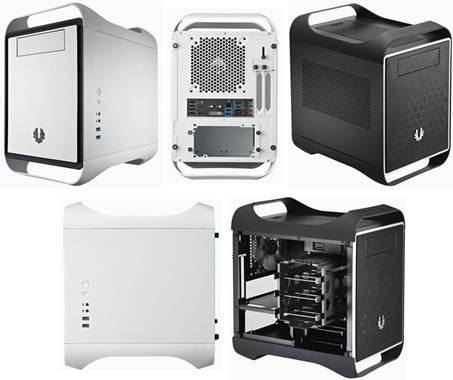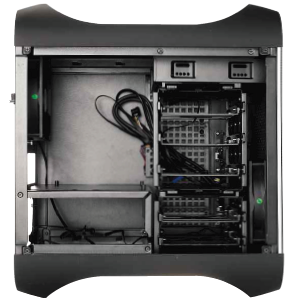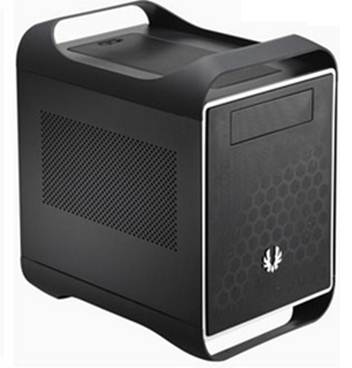Not without faults, but beats the
competition for just $97.5
BitFenix has clearly approached its new
mini-ITX case, the Prodigy, with a focus on flexibility and capability, as
opposed to getting everything into the smallest possible box. This means that
it's the largest and heaviest case on test (it isn't far off Silverstone’s
compact Micro-ATXTJ08-E in the volume stakes at 26 liters). It also boasts
cooling capabilities of cases twice its size, while still being undeniably
small and compact.

The Prodigy's exterior is dominated by its
curved FyberFlex handles, fitted to both the top and bottom of the core
chassis. Doubling as handles and case feet, the FyberFlex material is
incredibly hard-wearing and, true to its name, very flexible, while remaining
stiff enough to double as either a case foot or carry handle. However, the use
of FyberFlex in the permanent case feet means that the Prodigy wobbles
alarmingly with the lightest touch. Thankfully/, the FyberFlex panels are
removable, allowing you to substitute them for case feet of your own, albeit at
added expense.
Remove the handles and the Prodigy isn't
that much larger than competing chassis, yet it offers a great deal of cooling
potential. The mesh front fascia, secured with push-pins, hides a grilled front
that can mount a host of cooling fans, from 120mm to 230mm, without
compromising any of the interior fittings. The dust filter-equipped roof also
has mounts for a pair of 120mm fans, while the rear fan mount can accommodate
either a 120mm or 140mm fan.
The result is a case capable of mounting
the kind of cooling equipment you'd expect in a full-sized tower chassis, but
in a box little bigger than a desktop subwoofer. Even better, the pair of
roof-mounted 120mm fan mounts can accommodate a full-depth, dual 120mm water-
cooling radiator, something that even new full-sized cases such as the Fractal
Design Define R4, are unable to offer As standard, BitFenix pairs the case with
two 120mm fins, one of which acts as a front intake while the other is a rear
exhaust.
Alongside its array of cooling fan mounts,
the Prodigy is also extensively ventilated. The left side panel is perforated,
as is the floor of the case, although only the latter sports a removable dust
filter for the floor's PSU mount. Oddly, the case's front panel connectors are
found on the right-hand side panel, with a pair of USB3 ports, headphone and
microphone jacks, and both power and reset buttons matching the connector
arrays of the competition.

BitFenix
Prodigy
However, the case's exterior isn't without
fault, and we were surprised to find the side panels were a little loose around
their front fitting points, and therefore had a tendency to rattle. Similarly
to the FyberFlex feet, it's an annoying fault that's easily remedied with some
spare rubber spacers or tape, but it still detracted from what is otherwise a
solid and well put-together case.
Removing the aforementioned side panels,
the Prodigy's interior is incredibly roomy for a mini-ITX chassis, placing the
motherboard tray directly above the PSU mount. Despite the open interior, the
Prodigy can mount five 3.5i n drives in a pair of fully removable drives cages
(although you'll need to remove the upper three mounts if you have a graphics
card that's longer than 180mm). There are also four more 2.5in drive mounts
dotted around the interior of the case, as well as a removable 5.25in drive
mount in the case's roof, the removal of which is required for mounting a roof
radiator.
The decision to place the motherboard flat
in the case on top of the PSU cage means there's 175mm of CPU cooler headroom
too, so installing our test system was a snap. The PSU cage doubles as a place
to tuck your unused captive PSU cabling too and, as it's equipped with
cable-routing holes, cable tidying is straightforward, helping to keep
airflow-interrupting cables out of the way.
With our test kit fitted and under thermal
load, the Prodigy made the other cases on test look pedestrian, with a CPU
delta T of 43°C and a GPU delta T of 48°C - both results were the best on test
by some distance.

With
our test kit fitted and under thermal load, the Prodigy makes the other cases
on test look pedestrian.
In fact, the GPU temperature was 10°C
cooler than the next best case, giving the Prodigy a huge advantage. Not only
that, but the noise from the stock pair of fans was pleasantly unobtrusive,
even at full speed. With the Prodigy's highly expandable cooling, there's
plenty of room to improve it too.
Conclusion
The BitFenix Prodigy isn't without its
flaws, namely its wobbly FyberFlex feet and slightly loose side panels, but
these issues can be remedied easily and cheaply. It also compensates for these
problems with its great cooling capabilities, and the flexibility to mount highend water-cooling equipment should you
wish. What's more, building a system inside the Prodigy is straightforward, and
it's available for a bargain price of $97.5. While it isn't the smallest mini-
ITX case on test, it's undoubtedly the best.
Pros and
cons
Phoenix: Brilliant cooling; flexible fan
mounts; room for dual-120mm radiator; just $97.5
Ashes: Comparatively large; wobbly
FyberFlex base; side panels rattle slightly
How
much?
Price: $97.5 inc VAT
Scores
Cooling: 28/30
Features: 19/20
Design: 24/30
Value: 19/20
Overall: 90%
|